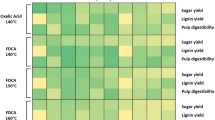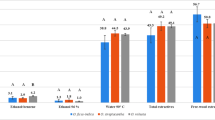Abstract
The expansion of industrial demand for lignocellulosic feedstocks increases the urgency for sustainable and rapid characterization of these raw materials, whose response could infer the suitability of all kinds of plants and agro-industrial residues for biorefinery processes. Thus, we developed an alternative composition and crystallinity analysis method via deconvolution of differential thermogravimetry (DTG) curves, which quantifies water and volatiles, extractives, hemicellulose, amorphous cellulose, crystalline cellulose allomorphs (I and II) and lignin fractions, both in natural lignocellulose and treated holocelluloses. The statistical assessment proved its high accuracy (R2 > 0.9993, F > 514,345 and SE < 0.1406) via analysis of variance (ANOVA), and the results for figures of merit showed its high precision (SD < 1.58, MSE < 2.13, MAE < 1.37 and ASRE < 5.45 × 10–3) in a 95% confidence level. Data acquisition is significantly faster than other standard methodologies, such as the analytical procedure NREL/TP-510-42618 created by the National Renewable Energy Laboratory. The alternative method can be performed in 1 day, requires less expensive apparatus and low energy consumption, in addition to producing almost no residue. In addition, it can be employed for an all-in-one evaluation (for composition, crystallinity, polymorphism, treatment efficiency and reactivity) of all kinds of lignocellulosic biomass, either raw or treated, with focus on enhancing biomass research and biorefinery processes.
Graphical Abstract



Similar content being viewed by others

References
Forbes (2022) Suzano e Klabin elevam preços da celulose em até US$ 125 por tonelada. https://forbes.com.br/forbesagro/2022/03/suzano-e-klabin-elevam-precos-da-celulose-em-ate-us-125-por-tonelada/
Preço da celulose sobe mais de 40% na China no primeiro semestre (2022). Tissue Online https://tissueonline.com.br/preco-da-celulose-sobe-mais-de-40-na-china-no-primeiro-semestre/#:~:text=Na%20China%2C%20maior%20consumidora%20mundial,de%20US%24%20840%20por%20tonelada. Accessed 10 Aug 2022.
Werpy T, Petersen G (2004) Top value added chemicals from biomass, part I—results of screening for potential candidates from sugars and synthesis gas. National Renewable Energy Lab., Golden, Colorado. https://www.nrel.gov/docs/fy04osti/35523.pdf
Dunning JW, Dallas DE (1949) Analytical procedures for control of saccharification operations. Anal Chem 21(6):727–729. https://doi.org/10.1021/ac60030a025
Van Soest PJ, Wine RH (1968) Determination of lignin and cellulose in acid-detergent fiber with permanganate. J AOAC Int 51(4):780–785. https://doi.org/10.1093/jaoac/51.4.780
Lorenzo-Santiago MA, Rendón-Villalobos R (2020) Isolation and characterization of micro cellulose obtained from waste mango. Polímeros. https://doi.org/10.1590/0104-1428.09119
Hussain MA, Huq ME, Rahman SM, Ahmed Z (2002) Estimation of lignin in jute by titration method. Pak J Biol Sci 5(5):521–522. https://doi.org/10.3923/pjbs.2002.521.522
Banerjee S, Singh R, Eilts K, Sacks EJ, Singh V (2022) Valorization of Miscanthus × giganteus for sustainable recovery of anthocyanins and enhanced production of sugars. J Clean Prod 369:133508. https://doi.org/10.1016/j.jclepro.2022.133508
Campos LMA, Moura HOMA, Cruz AJG, Assumpção SMN, Carvalho LS, Pontes LAM (2022) Response surface methodology (RSM) for assessing the effects of pretreatment, feedstock, and enzyme complex association on cellulose hydrolysis. Biomass Convers Biorefin 12:2811–2822. https://doi.org/10.1007/s13399-020-00756-4
Escobar ELN, Suota MJ, Ramos LP, Corazza ML (2022) Combination of green solvents for efficient sugarcane bagasse fractionation. Biomass Bioenergy 161:106482. https://doi.org/10.1016/j.biombioe.2022.106482
Li J, Wang Y, Zhu W, Chen S, Deng T, Ma S, Wang H (2022) A novel mechanocatalytical reaction system driven by fluid shear force for the mild and rapid pretreatment of lignocellulosic biomass. J Waste Manag 148:98–105. https://doi.org/10.1016/j.wasman.2022.05.026
Sluiter A, Hames B, Ruiz R, Scarlata C, Sluiter J, Templeton D, Crocker D (2008) Determination of structural carbohydrates and lignin in biomass. Laboratory analytical procedure. NREL 1617:1–16
Rego F, Dias APS, Casquilho M, Rosa FC, Rodrigues A (2019) Fast determination of lignocellulosic composition of poplar biomass by thermogravimetry. Biomass Bioenergy 122:375–380. https://doi.org/10.1016/j.biombioe.2019.01.037
Putri KNA, Kaewpichai S, Keereerak A, Chinpa W (2021) Facile green preparation of lignocellulosic biosorbent from lemongrass leaf for cationic dye adsorption. J Polym Environ 29:1681–1693. https://doi.org/10.1007/s10924-020-02001-5
Hideno A (2016) Comparison of the thermal degradation properties of crystalline and amorphous cellulose, as well as treated lignocellulosic biomass. BioRes 11:6309–6319. https://doi.org/10.15376/biores.11.3.6309-6319
Carrier M, Loppinet-Serani A, Denux D, Lasnier J-M, Ham-Pichavant F, Cansell F, Aymonier C (2011) Thermogravimetric analysis as a new method to determine the lignocellulosic composition of biomass. Biomass Bioenergy 35:298–307. https://doi.org/10.1016/j.biombioe.2010.08.067
Díez D, Urueña A, Piñero R, Barrio A, Tamminen T (2020) Determination of hemicellulose, cellulose, and lignin content in different types of biomasses by thermogravimetric analysis and pseudocomponent kinetic model (TGA-PKM method). Processes 8(9):1048–1069. https://doi.org/10.3390/pr8091048
Peng Y, Tang X, Xuan R, Wang L, Dai L, Zhang L, Liao F, Li H, Li X, Shen Y, Su Y, Wang H (2021) Analysis of pyrolysis behaviors of biomass extractives via non-linear stepwise heating program based on Gaussian multi-peak fitting of differential thermogravimetric curve. Thermochim Acta 702:178976. https://doi.org/10.1016/j.tca.2021.178976
Marasca N, Cardoso IA, Rambo MKD, Bertuol DA, Rambo MCD, Guarda EA, Scapin E (2022) Ultrasound assisted pretreatments applied to cupuaçu husk (Theobroma grandflorum) from Brazilian legal Amazon and biorefinery concept. J Braz Chem Soc 33:906–915. https://doi.org/10.21577/0103-5053.20220005
Moura HOMA, Campos LMA, Silva VL, Andrade JCF, Assumpção SMN, Pontes LAM, Carvalho LS (2018) Investigating acid/peroxide-alkali pretreatment of sugarcane bagasse to isolate high accessibility cellulose applied in acetylation reactions. Cellulose 25:5669–5685. https://doi.org/10.1007/s10570-018-1991-0
Stahle L, Wold S (1989) Analysis of variance (ANOVA). Chemom Intell Lab Syst 6:259–272. https://doi.org/10.1016/0169-7439(89)80095-4
Saldarriaga JF, Atxutegi A, Aguado R, Altzibar H, Bilbao J, Olazar M (2017) Correlations for calculating peak and spouting pressure drops in conical spouted beds of biomass. J Taiwan Inst Chem Eng 80:678–685. https://doi.org/10.1016/j.jtice.2017.09.001
Rocha GJM, Nascimento VM, Rossell CEV (2014) Caracterização físico-química do bagaço da cana-de-açúcar. Technical Memorandum, CTBE. http://8k5sc3kntvi25pnsk2f69jf1.wpengine.netdna-cdn.com/wp-content/uploads/2016/08/MeT-102014-port.pdf
Sluiter A, Hames B, Hyman D, Payne C, Ruiz R, Scarlata C, Sluiter J, Templeton D, Wolfe J (2008) Determination of total solids in biomass and total dissolved solids in liquid process samples. Laboratory analytical procedure. NREL 1617:1–9
Sluiter A, Ruiz R, Scarlata C, Sluiter J, Templeton D (2008) Determination of extractives in biomass. Laboratory analytical procedure. NREL 1617:1–12
Shariff A, Aziz NSM, Ismail NI, Abdullah N (2016) Corn cob as a potential feedstock for slow pyrolysis of biomass. J Phys Sci 27(2):123–137. https://doi.org/10.21315/jps2016.27.2.9
Mohammed IY, Abakr YA, Kazi FK, Yusuf S, Alshareef I, Chin SA (2015) Pyrolysis of napier grass in a fixed bed reactor: effect of operating conditions on product yields and characteristics. BioRes 10(4):6457–6478. https://doi.org/10.15376/biores.10.4.6457-6478
Yang H, Yan R, Chen H, Zheng C, Lee DH, Liang DT (2006) Investigation of biomass pyrolysis based on three major components: hemicellulose, cellulose and lignin. Energy Fuels 20:388–393. https://doi.org/10.1021/ef0580117
Kok MV, Ozgurb E (2017) Characterization of lignocellulose biomass and model compounds by thermogravimetry. Energy Sources Part A 39:134–139. https://doi.org/10.1080/15567036.2016.1214643
Credou J, Berthelot T (2014) Cellulose: from biocompatible to bioactive material. J Mater Chem B 2:4767–4788. https://doi.org/10.1039/C4TB00431K
French AD, Santiago Cintrón M (2013) Cellulose polymorphy, crystallite size, and the Segal Crystallinity Index. Cellulose 20:583–588. https://doi.org/10.1007/s10570-012-9833-y
Brienzo M, Carvalho AFA, Figueiredo FC, Oliva Neto P (2016) Sugarcane bagasse hemicellulose properties, extraction technologies and xylooligosaccharides production. Food Waste 1:155–188
Li X, Xu R, Yang J, Nie S, Liu D, Liu Y, Si C (2019) Production of 5-hydroxymethylfurfural and levulinic acid from lignocellulosic biomass and catalytic upgradation. Ind Crops Prod 130:184–197. https://doi.org/10.1016/j.indcrop.2018.12.082
Mamman AS, Li J-M, Kim Y-C, Hwang IT, Park N-J, Hwang YA, Chang J-S, Hwang J-S (2008) Furfural: hemicellulose/xylose derived biochemical. Biofuel Bioprod Biorefin 2:438–454. https://doi.org/10.1002/bbb.95
Mozdyniewicz DJ, Nieminen K, Sixta H (2013) Alkaline steeping of dissolving pulp. Part I: cellulose degradation kinetics. Cellulose 20:1437–1451. https://doi.org/10.1007/s10570-013-9926-2
Dungani R, Owolabi AF, Saurabh CK, Abdul Khalil HPS, Tahir PM, Hazwan CICM, Ajijolakewu KA, Masri MM, Rosamah E, Aditiawati P (2017) Preparation and fundamental characterization of cellulose nanocrystal from oil palm fronds biomass. J Polym Environ 25:692–700. https://doi.org/10.1007/s10924-016-0854-8
Acknowledgements
The authors thank the Analytical Center of the Institute of Chemistry (UFRN, Natal, BR) for the TG/DTG analysis.
Funding
This study was financed in part by the Conselho Nacional de Desenvolvimento Científico e Tecnológico—Brazil (CNPq)—Finance Code 154372/2019-6, and the Coordenação de Aperfeiçoamento de Pessoal de Nível Superior—Brazil (CAPES)—Finance Code 001.
Author information
Authors and Affiliations
Contributions
All authors contributed to the study conception and design. HOMAM performed all the deconvolutions and ANOVA assessment, wrote the manuscript, and prepared figures and the ESM file. ABFC calculated all the figures of merit, prepared tables and formated the ESM file. LMAC performed the composition analysis via NREL methodology. LSC suppervised the overall work, revised the text and discussed the results with all authors. All authors read and approved the final manuscript.
Corresponding author
Ethics declarations
Conflict of interest
The authors declare that they have no conflict of interest.
Ethical Approval
The authors have followed the guidelines of the Committee on Publication Ethics.
Consent to Participate
Not applicable.
Consent for Publication
All authors have read and agreed to publish the latest version of the manuscript.
Additional information
Publisher's Note
Springer Nature remains neutral with regard to jurisdictional claims in published maps and institutional affiliations.
Supplementary Information
Below is the link to the electronic supplementary material.
Rights and permissions
Springer Nature or its licensor (e.g. a society or other partner) holds exclusive rights to this article under a publishing agreement with the author(s) or other rightsholder(s); author self-archiving of the accepted manuscript version of this article is solely governed by the terms of such publishing agreement and applicable law.
About this article
Cite this article
Moura, H.O.M.A., Câmara, A.B.F., Campos, L.M.A. et al. Novel Methodology for Lignocellulose Composition, Polymorphism and Crystallinity Analysis Via Deconvolution of Differential Thermogravimetry Data. J Polym Environ 31, 1915–1924 (2023). https://doi.org/10.1007/s10924-022-02723-8
Accepted:
Published:
Issue Date:
DOI: https://doi.org/10.1007/s10924-022-02723-8



